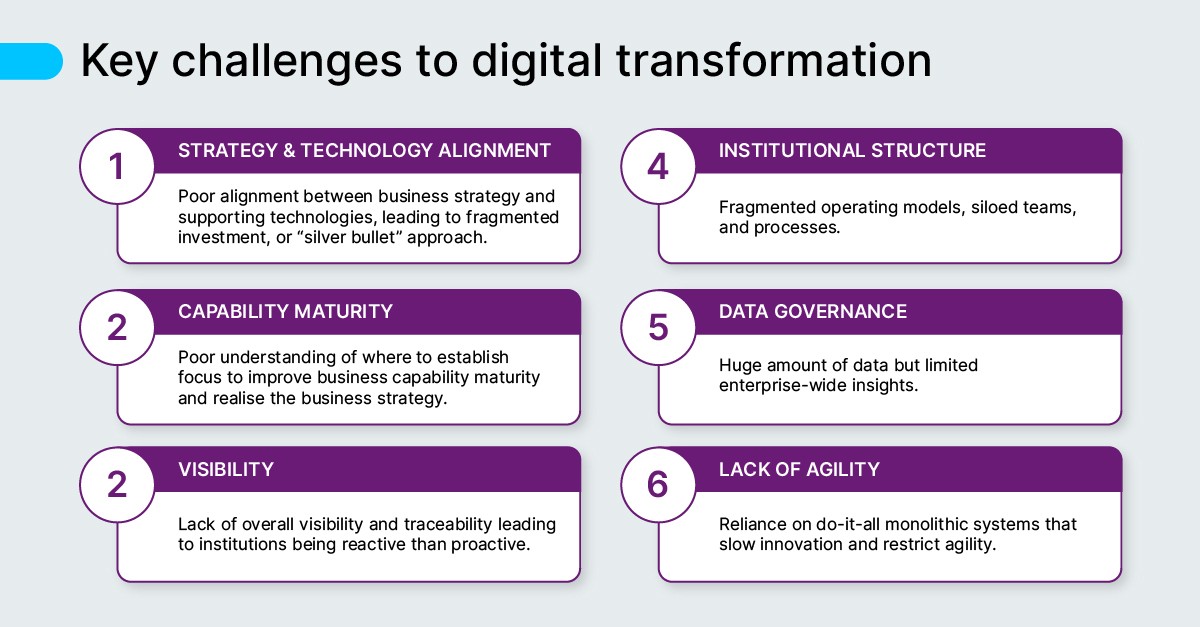Drive down risk and cost while accelerating Digital Transformation

The challenge
Higher education is a highly complex business. Like small municipalities, institutions manage everything from their core business of teaching, learning, and research to facilities, retail, and accommodation. Some even manage hospitals. Accordingly, the number of systems used to address these operations tend to be vast and complex.
Post-COVID, there has been an accelerated focus on enabling Digital Transformation (Dx) as institutional leaders push to simplify business processes to reduce cost and differentiate their offerings through personalised and targeted student experiences.
However, in most cases, institutions struggle to deliver effective Dx across the entire student lifecycle due to the large number of applications used to support this journey.

What is Digital Transformation?
At Ellucian, we’re dedicated to helping institutions gain competitive advantage by putting them at the forefront of higher ed technology. That’s our goal as we partner with institutions around the world: to build a more connected, efficient future in the cloud with architecture that is agile, resilient, and designed for an era of rapid change.
Together, we’re empowering higher ed to adapt, thrive, and help their students, faculty, and staff work smarter every day.
Review of Digital Transformation today
In Australia, for those institutions that have started their digital transformation journey, most have focussed on marketing automation, recruitment, and website consolidation, predominantly with Adobe, Salesforce, or Microsoft Dynamics, choosing to leave the incumbent core systems in place.
While this approach can provide a compelling journey for prospective students, continuing and newly enrolling students are left wanting as they struggle with a disjointed experience.

One of the major causes for this disconnected experience is that many of the incumbent core student systems in use across the sector today are highly customised monoliths whose business processes have been refactored many times. This creates a mess of interconnected, disjointed legacy processes that are difficult to deconstruct and almost impossible to integrate.
Combine that with the fact that many of the staff who understand these customisations are single points of failure, and the skills required to maintain these customisations are costly and rare, puts the institution at significant risk.
Delivering the complete student journey
Akin to the role of a banking system, the student system is core to an institution's operation and is central and fundamental to the student experience. The experiences offered by this system are just as important, if not more important, as students select their study paths, plan their timetables, and navigate their journey as they progress to completion.
Ideally, the student system should form the foundation for building a successful student journey. While institutions like Western Sydney University have achieved this across the entire lifecycle, many have started with recruitment alone, only to find that the incumbent student system hinders their ability to deliver a complete Dx.
Mapping a digital transformation roadmap
To understand what is needed to deliver the complete life cycle experience, institutions must first understand their existing application assets, desired outcomes, and business capability requirements and create a roadmap to success. This can be achieved via a 5-step process.

- Asses the Strategic Outcome: The strategy Assessment Workshop is designed to deliver a high-level visual representation of a client’ strategic objectives, how they are to be realised and provide an understanding of the current and desired level of operational maturity in terms of achieving these objectives.
- Understand your Application Portfolio: The Application Portfolio Assessment service is designed to evaluate the client’s existing Information Technology (IT) application portfolio to better understand its business value and technology maturity. The outcome of this exercise will provide a strong foundation for clients to visualise the current state of their application portfolio and facilitate decisions about existing and new IT investments.
- Understand Current State: The Current State Assessment service is designed to document the client’s high level current state architecture at the Business, Data, Application and Technology layers. This will provide the client with a clear overall view of their business functions, processes, Information Systems (IS), and individual technical platforms, such as servers and databses, and their mutual dependencies.
- Deliver Architecture Solution Design: The Solution Architecture Design service is designed to deliver a high-level visual representation of how the client’s strategic and business objectives will be delivered by Ellucian solutions and potentially other 3rd party solutions whenever applicable. This service is provided as part of an implementation project.
- Architecture Assurance: The Solution Architecture Assurance service is designed to ensure that the solution delivered to the client is as per agreed in relation to pre-delivery solution architecting and is in alignment with any of the clients pre-stated design principles. This service is provided part of an implementation project.
Ellucian has invested significantly to develop a business capability model, which is aligned to the CAUDIT (Council of Australasian University Directors of IT) and UCISA (Universities and Colleges Information Systems Association) reference models to deliver a system-agnostic, proven practice model.
This answers the fundamental question:
What capabilities do I need from the student system in my existing application Investment and Planned Investment?
Higher education has an opportunity to offer their own continuing education programs for alumni and other adult learners, but consumer-first trends will continue to drive the market. By embracing flexible, robust workforce development, institutions can stay competitive while addressing the pressing need for training today.
What next?
Once the business capability model for your institution has been mapped, the next stage is to align this to your application ecosystem. The question is, do these systems provide all the capabilities required? Do they deliver to the experience expectations? And do they provide the outcome aligned to your strategy?
Flexibility and agility are key factors because success is highly dependent on the system's ability to plug and play with other applications in your ecosystem.
The monolith is dead
Based on the challenges faced in delivering to student expectations, most institution leaders understand that the traditional monolithic student system is simply incapable of delivering on the future needs of a modern institution environment.
Working with our customers and industry leaders, this is something that we have come to understand and the driver for our significant investment in the delivery of a new platform – the Ellucian Experience Platform.
This new modern student platform (announced by our CTO) was introduced to the higher education community at Ellucian Live 2022. Built on the premise of delivering plug-and-play student system capabilities, this open microservice based platform is SaaS delivered and can offer discreet best-in-breed functions that leverage your existing investments.

The landscape has changed with the release of Ellucian's Experience open SaaS based microservices platform. With institutions now able to deliver only the core business capabilities needed from student management, to fully enable their digital transformation strategy.
The game-changer
By bringing together the business capability model and Ellucian's Experience platform, we can provide a roadmap for success that delivers the student capabilities required, aligned to your application investment, to enable a market-leading experience across your entire student life cycle.
The business benefits
By focussing only on the core student capabilities, the scope for the replacement of your incumbent system will be minimised (i.e., we are only delivering the minimal viable product required). This will significantly reduce the cost, risk, and timescale for delivery.
- Reduced cost
- Reduced risk
- Minimal viable product approach to delivery – leveraging your existing applications
- Modern, cost-effective future-proofed platform
- Plug and play ecosystem components to promote agility
- Lower maintenance costs (integration, maintenance, and development)
- Increased choice by leveraging our 150 partners to add extra value
- Flexibility to add your systems and leverage common capability (via SDK)




